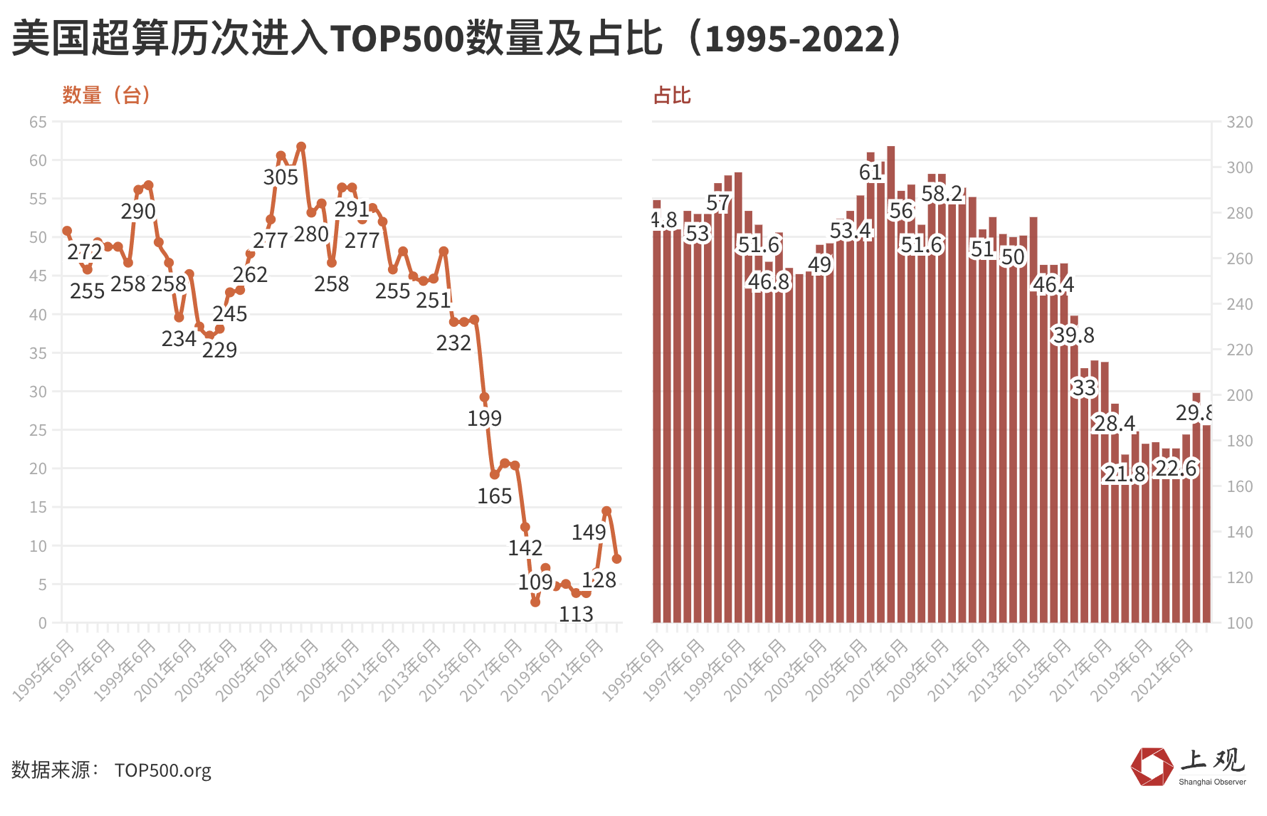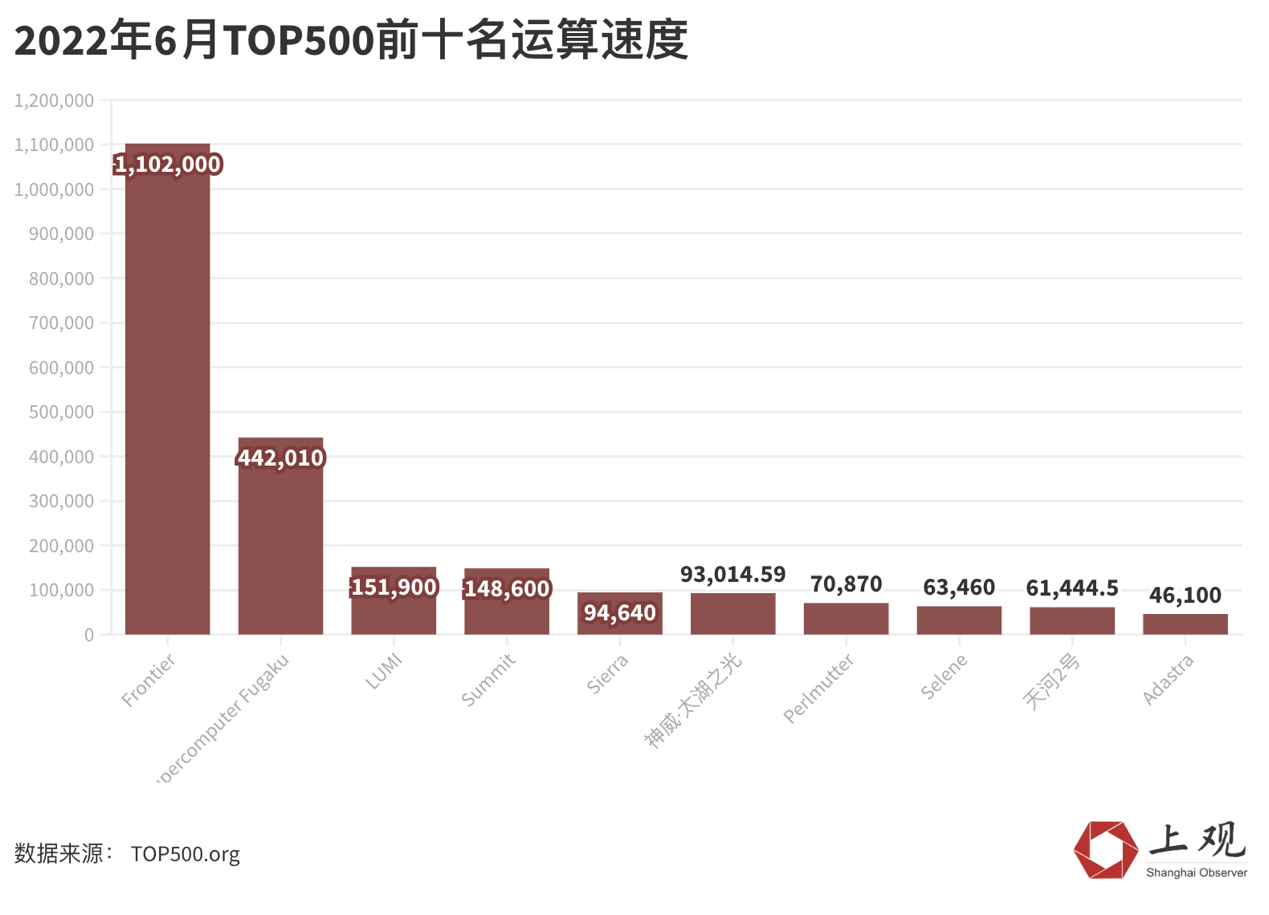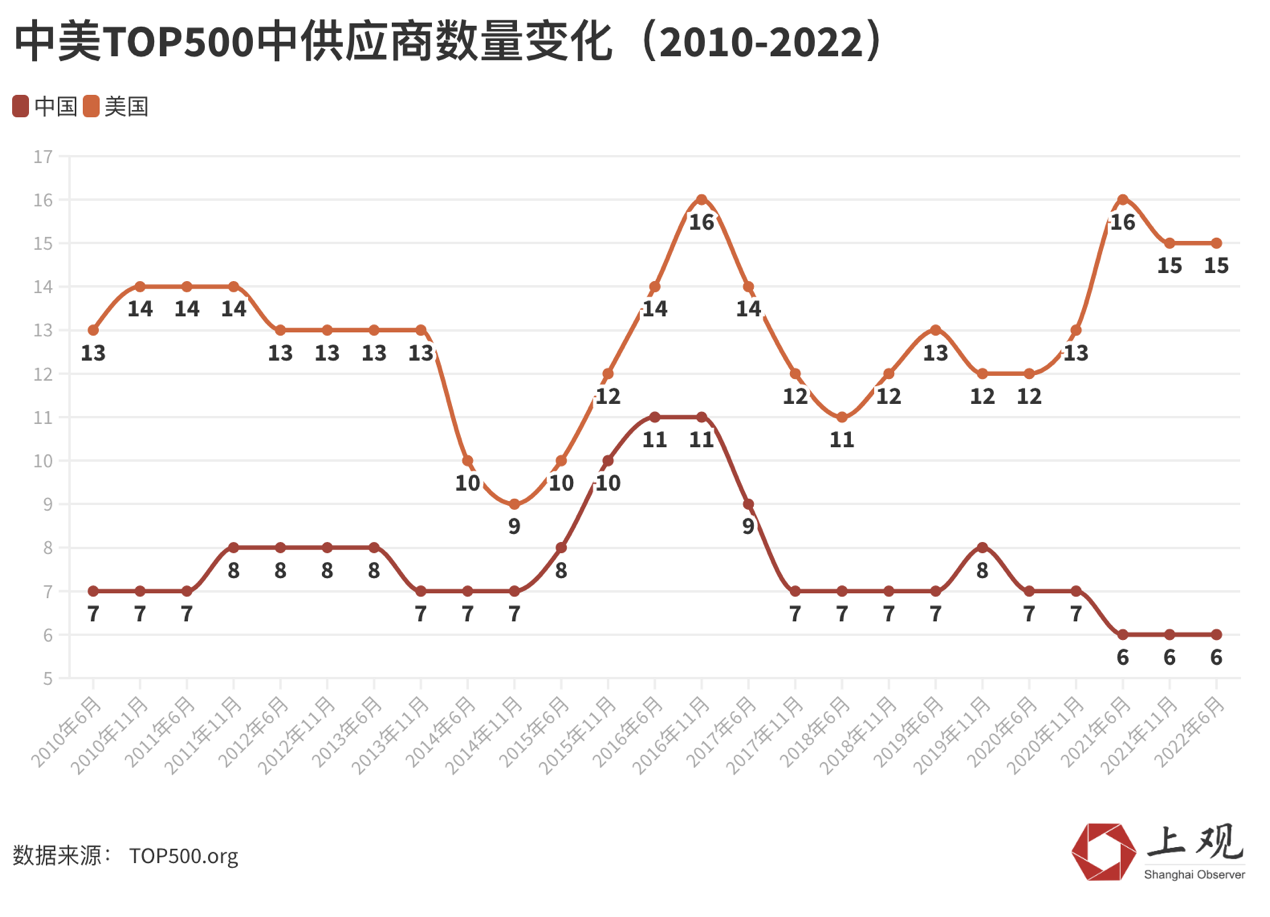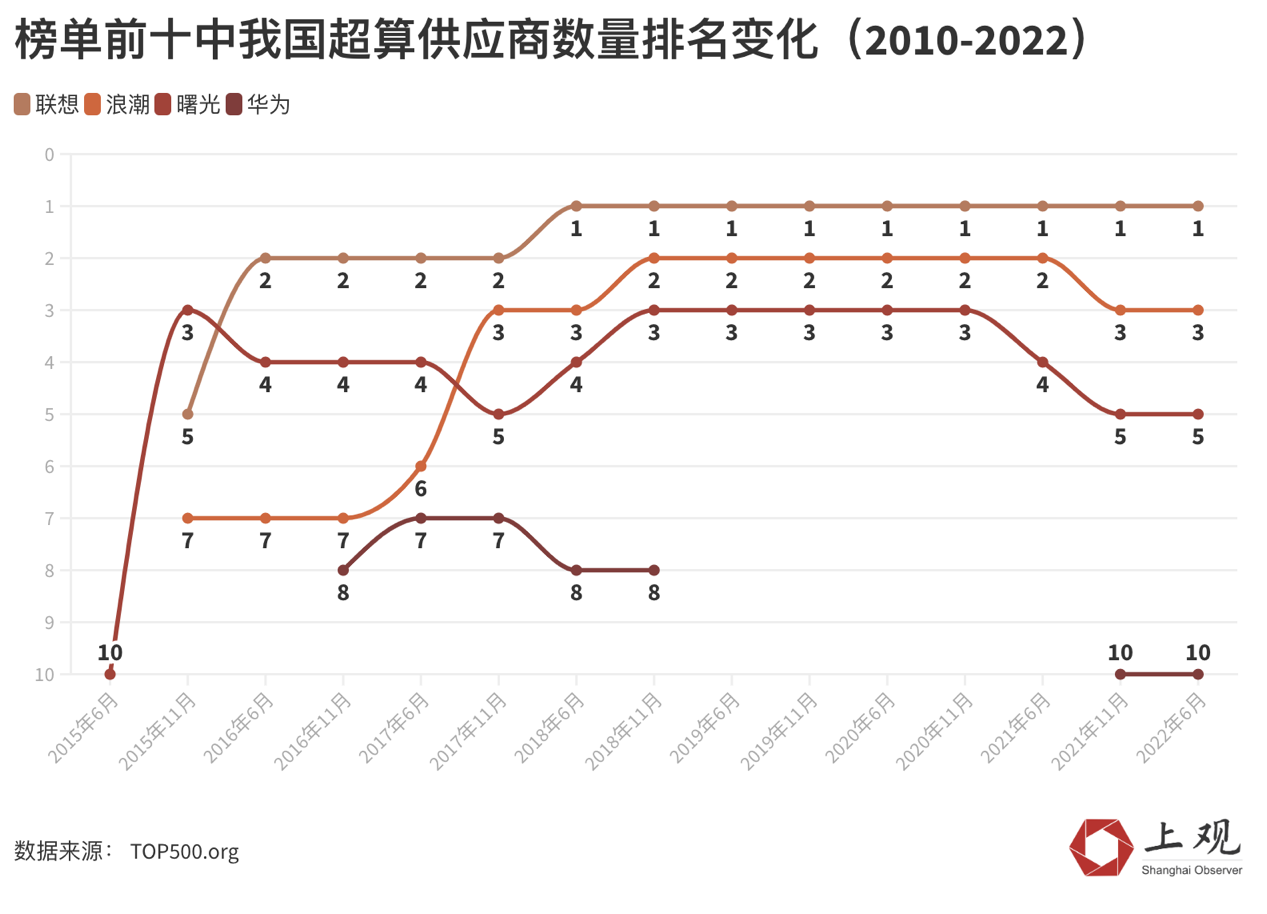The latest "TOP500" list of supercomputers ranks first in the United States. Is China behind in supercomputing?
On May 30th, the 59th ISC2022 (International Supercomputing Conference) released the latest TOP500 list. The "Frontier" of Oak Ridge National Laboratory (ORNL) in Tennessee, USA, scored 1.102 exaflops, becoming the first supercomputer to truly break through the Exascale mark.
And in this list,China’s Shenwei Taihu Lake Light ranks sixth, and Tianhe No.2 ranks ninth, which is lower than that of previous years, and its computing power is not as good as one tenth of that of the United States.?
Supercomputing has long been regarded as one of the symbols of comprehensive national strength. Because the computing power far exceeds that of ordinary computers, the application scenarios of supercomputing include nuclear explosion test, weather forecast, astrophysical simulation, cryptanalysis and other fields.
The TOP500 list is compiled by the international organization "TOP500", which ranks the installed supercomputers in the world and is published once every six months. It is worth mentioning that the TOP500 is ranked according to the calculation speed, that is, how many floating-point operations can be performed per second.
So, has China’s supercomputing power fallen behind?
The number of China supercomputers entering the TOP500 ranks first in the world.
To see the strength of a country’s supercomputer, in addition to the calculation speed of a single supercomputer, it also depends on the number of supercomputers that a country can list.
This time, a total of 173 supercomputers in China entered the TOP500 list, accounting for 34.6% of the world, ranking first;The second-ranked United States has 128 supercomputers on the shortlist, accounting for 25.6%; In Japan, which ranked third, 33 entered the list, accounting for 6.6%.?
Actually, fromSince 2016, the number of Chinese super-calculations entering the TOP500 list has basically remained in the first place in the world except for a slight decline in June 2017.
Compared with Europe, America, Japan and other countries, China started late in supercomputing. In June 1995, China’s supercomputer first appeared in the TOP500 list. In the next 17 years, the number of supercomputers entering the TOP500 list in China has been rising, with a maximum of 228, accounting for 45.6% of the list.
 ?
?
The number of Americans entering the list has dropped significantly compared with the peak.

But after 2016, China and the United States are catching up with each other, which can be described as "two men competing for hegemony", and almost take turns to be the champion and runner-up in the number of super-calculations.
China has not submitted the test data of the E-class prototype.
From the speed of single supercomputer, China was the first frequent visitor.
2010In 2006, China’s "Tianhe II" was born and won the first place in the list, which is also the first place in China’s supercomputer.
However, in the latest super-calculation ranking, China ranked out of the top five. Among them, Shenwei Taihu Light ranked sixth, and Tianhe No.2 ranked ninth.

Compared with previous years, China’s ranking is indeed much lower, and it is not high compared with other supercomputers in the list, even less than one tenth of the "frontier" of the United States.

What is the reason?
If we study this list carefully, we will find that China’s super-calculated production time is really a little "long" compared with other countries.
This is not only reflected in this year’s list. In the previous eight lists released by TOP500, the production time of Shenwei Taihu Light and Tianhe 2, the top ten in China, was 2016 and 2018 respectively.
Supercomputers from other countries in the top ten on the list were almost all produced in the past two years. For example, the "frontier" where the United States won the title in 2022 was produced and delivered in 2021, while the "Fuyue" where Japan won the title in 2021 and 2020 was produced and delivered in 2020.

In the field of supercomputing, a year and a half can differ by an era. For example, the "frontier" of the US hegemony isThe first supercomputer that really broke through the Exascale mark, its performance reached 1.102exaflops, which also marked a new era of supercomputing.The arrival of e-class supercomputer.
In addition to the "frontier", the United States also has two E-class supercomputers, "Aurora" and "Emirates Rock", which are also under construction.
So, is China lagging behind in the field of E-class supercomputer? This is not the case.
As early as 2016, Zhongke Shuguang officially launched the development project of E-class supercomputer. In 2018, Tianhe No.3 prototype and Shenwei E-class prototype began to enter the host R&D and deployment. In 2018, CCTV also disclosed that the prototype of "Tianhe No.3" passed the acceptance test, and its computing power reached E level. At present, three prototype systems with different technical routes have been delivered in China: Shenwei E-class prototype, Tianhe-3 E-class prototype and Shuguang E-class prototype.
However, China did not submit the test data of the E-class prototype this time. Many foreign media infer that the peak value of Shenwei E-class supercomputer on HPL benchmark is about 1.3 exaflops/1.05 exaflops, while Tianhe No.3 can reach the peak value of 1.7 exaflops /1.3 exaflops, both exceeding Frontier’s 1.102 exaflops.
Looking at the mystery behind the list from the super-calculation suppliers
The question is: why don’t we take the latest supercomputer and American PK?
This is a bit complicated to say.

The above picture is a comparison between China and the United States of the global supercomputer suppliers. It can be found that,The number of over-calculated suppliers in China is getting less and less in TOP500.From 2021, there are only six left, even lower than the seven in 2010. In the TOP500 list released in November 2016, the number of super-calculated suppliers in China has reached 11, which is very small compared with the United States.
On the contrary, American Supercomputer has more and more suppliers.In recent two years, the number of suppliers is even more than twice that of China.
In addition, China suppliers who have appeared in the TOP500 in recent years are still old faces. For example, Lenovo, which has won the first place for many times, has participated in the manufacturing and deployment of 161 supercomputers, accounting for 32.2% in the world; There are 50 finalists in Inspur, accounting for 10%, ranking third; Shuguang ranked fifth with 36 units, accounting for 7.2%; Huawei ranked tenth with 1.4%.

Why are there fewer and fewer super-calculated suppliers in China on the list?
On the one hand, China relies less and less on multinational companies in supercomputing.After 2016, companies such as IBM, Dell, Hewlett-Packard, etc. appear less and less frequently among China’s supercomputing suppliers. Since 2021, only our own companies and institutions remain in the list of supercomputing suppliers in China, including Lenovo, Zhongke Shuguang, Inspur, National University of Defense Technology, National Center for Parallel Computer Engineering and Technology (NRCPC) and Huawei.
On the other hand, the TOP500 on the list is more likely to be included in the entity list by the US.
On April 8, 2021, Tianjin Feiteng Information Technology Company, Shanghai Integrated Circuit Technology and Industry Promotion Center, Sunway Microelectronics, National Supercomputing Jinan Center, National Supercomputing Shenzhen Center, National Supercomputing Wuxi Center and National Supercomputing Zhengzhou Center were blacklisted by the United States; In June 2019, the United States included Zhongke Shuguang, Haiguang, Chengdu Haiguang, Chengdu Haiguang Microelectronics Technology and Jiangnan Computing Technology Research Institute in the entity list; Back in 2015, National University of Defense Technology, Changsha National Supercomputing Center, Guangzhou National Supercomputing Center (NSCC-GZ) and Tianjin National Supercomputing Center were listed by the United States. Being included in the list of entities means that the above-mentioned companies must obtain permission from the US government before doing business with American companies, and the United States intends to fundamentally prohibit these companies from acquiring almost all advanced technologies developed in the United States.
Lin Xinhua, deputy director of the Network Information Center of Shanghai Jiaotong University and an HPC expert, said that TOP500 has become a de facto entity list. "Entering TOP500 is to promote international cooperation, but the result is counterproductive."
This is why China will no longer provide the latest data of supercomputing after 2020.
Looking at the rankings in recent years, the real players in the field of supercomputing are actuallyUnited States, China and Japan.And the ranking will not change much in a short time.
Under the background that the US government has repeatedly generalized the concept of national security, abused state power, abused the list of entities, and suppressed China’s high-tech enterprises maliciously by all means in order to safeguard its own monopoly and hegemonic position in science and technology and curb China’s development,It may be a kind of wisdom to choose the angle of exposure in the list.